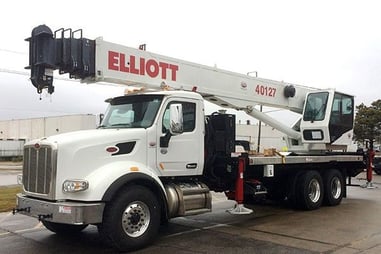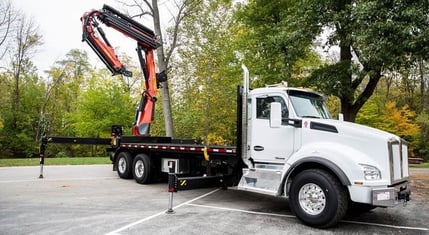Just last month, ITI VR released the Virtual Reality Boom Truck Simulator. I had the opportunity to sit down with ITI Founder and Technical Director, Mike Parnell, to discuss how boom trucks are used across industries and how ITI informed the instructional design of the unique scenarios for the ITI VR Boom Truck Simulator.
Amanda Henry: Who operates boom trucks, in what environments, and what unique load handling assignments is this machine made for?
Mike Parnell: Generally, boom trucks are operated by people who are involved in the delivery of components and product from some distribution point to a job site. Examples include drywall, sheet rock, lumber, welders, light plants, things that come from equipment rental companies, and construction sites. Boom trucks are designed to drive on most highways and roads, and are self-loading and off-loading, from their own deck. This enables efficient delivery of products by a single operator/driver.
In some cases, boom trucks are also used for some small construction elements; potentially in residential roofing where trusses are being delivered, and to be able to handle the trusses and place them up onto the walls for installation. More often, the operators are landing their objects on the ground and the crew/user group will take control of the items. The environment that they are used in is probably 90% construction related and 10% general industry. In general industry, it wouldn't be unusual to find a boom truck at a facility like a power plant or refinery for general maintenance activities. But, in general, boom trucks typically assist in the construction process pipeline, maybe not in the construction act, but they are assisting on the supply side. The operators typically have a commercial driver’s license. They are typically operated by delivery personnel who have been additionally qualified in boom truck operation.
AH: What are the most common boom truck models available in the field including make, model, capacities, engineering specs?


MP: The most common boom trucks we will see are of a fixed-cab design. Twin to the boom truck family is the articulating crane which has multiple boom sections that hinge or fold in and out with small winches and hooks. A boom truck itself in this vain is a telescopic, straight, multi-sectioned boom that can be mounted up by the cab, right behind the cab, center of the deck, rear center, or rear corners. So, the boom truck is typically mounted on some other power source such as a GMC, Ford, or other make or manufacturer of truck. Some of the larger boom truck manufacturers include Manitex, National, Elliot, and Terex – those providers have a whole series of booms that they have manufactured that go on a wide variety of truck bases. For example, Terex doesn’t make the truck, they make the boom and conduct final assembly. So, you have to pick the truck base that you want your boom on, and then add the boom and stabilizers second.
Most common capacities are between 10 and 50 tons. Each of those manufacturers do make boom truck capacities in the 70, 80, and 90-ton range if not more with booms that can reach 150 to 180-ft. The bread and butter booms (highly-technical term) would be 10 to 30-ton and a boom length of 35 to 105-ft for reach. Generally, two main stabilizers or outriggers are placed off the back end. Time to time, they will need a front jack off the front bumper to provide or allow full capacity if necessary based on the truck design. The load charts are typically 360 degrees and in some cases, on the older machines, they may only have a 180 degree chart. The truck decks are typically anywhere from 14 to 20-ft, and then those are suitable to place loads, components, and product on for transit.
AH: What operational challenges are unique to boom trucks, compared to other heavy equipment, that ITI took into consideration when designing training and assessment scenarios in the ITI VR Boom Truck Simulator?
MP: Several challenges for operating boom trucks relate to the fixed-cab nature of the equipment including lift planning and obstructed lifts. Boom trucks typically have two operator stands (e.g. cabs or stations), referred to as "curb-side" and "street-side". Selecting an optimal parking location and orientation is important for an efficient and safe operation. This is no different than any other crane type that requires positioning the crane and setting up for success. In addition to proper planning, the ability to operate the machine from both cabs (operator orientations) is also important - sometimes, an operator is forced to operate from one side or the other given the circumstances.
A major risk that is often overlooked with boom trucks that has to do with lift planning is related to the constant drive, park/setup, lift, stow, and drive process an operator must take a boom truck through. A boom truck operator might make three to five lifts per day, all at varying load weights and set points. This requires a boom truck operator to dogmatically work the load chart for each lift, and not become complacent. This isn't very different from other crane types, except for the fact that a boom trucks boom length (which effects capacity) may change for every lift. On larger telescopic cranes, it is very common for a crane to be setup at one boom length for the day, week or month to make several picks. The boom truck operator must repeatedly telescope the boom, from a stowed position, and check their chart with their new boom length and set point (radius). In ITI VR, we have designed the system to allow for us to toggle on a load chart exercise for every simulated lift so that operator's can gain load chart practice from the virtual cab.
Going back to obstructed lifts, we simulate dozens of scenarios that involve obstructed perspectives so that an operate must follow hand signals, voice commands, and even learn to alter their perspective by leaning and peering around the deck to ensure a soft load landing on the ground - something you can only do in VR [Mike winks]. Obstructions can be caused by a deck full of product, the set-point "beneath" the deck and out of visibility, the truck cab, the boom turret, and any off-crane obstructions per usual crane operations.
Generally speaking, training boom truck operations is very similar to other crane types and heavy equipment. Operators tend to need time getting used to the speed of the machine and operation. Sometimes boom trucks move a little quicker based on lever manipulation and a little jerkier than you would expect or might see on a normal swig cab crane. Operators must familiarize themselves with the controls and levers, and understand the speed of the hydraulic flow through the system so they can manage and minimize dynamic loading of the boom and the load.
AH: Is there anything about virtual reality that makes training and assessing boom truck operations more advantageous?
MP: As I mentioned, because the boom truck is a fixed-cab experience, pick and set points can physically be behind the operator. A 60" flat-screen cannot replicate the 360-degree spherical world we live in. In VR, you can pick the load at 2 o'clock, set it at 7 o'clock, while standing at your virtual boom truck station. You can't do that on a flat-screen TV. That's the power of VR.
Additionally, as I think we could probably identify with almost all of the machines we are simulating, the task assignment for load handling can be achieved at a much quicker pace. The actual rigging time – load handling, staging, landing, blocking, securing – has its own natural pace in a live environment, while in a virtual reality environment, tasks can be accomplished potentially at a rate of 4-5 times the frequency. Reset/reboot without any risk to real equipment, real people, and/or load and objects being handled. So, the advantage is being able to get more lifting activities performed in an hours’ time with virtually no risk to people or assets. This is where our customers are seeing significant cost savings in their training and qualification processes.
To learn more about how VR training simulators can help your team, click here or use the button below.




COMMENTS